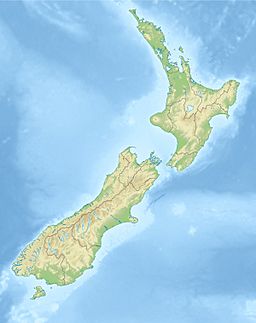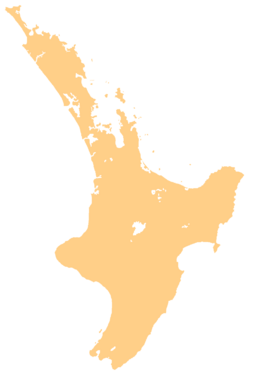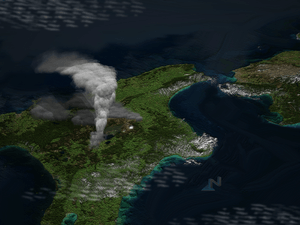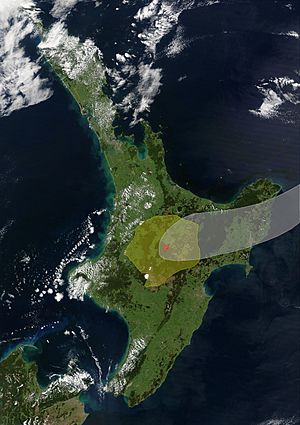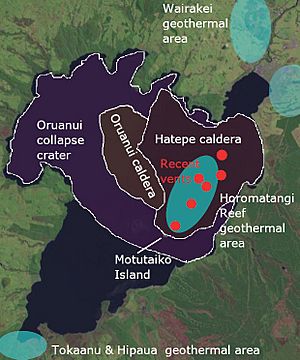Taupō Volcano facts for kids
Quick facts for kids Taupō Volcano |
|
|---|---|
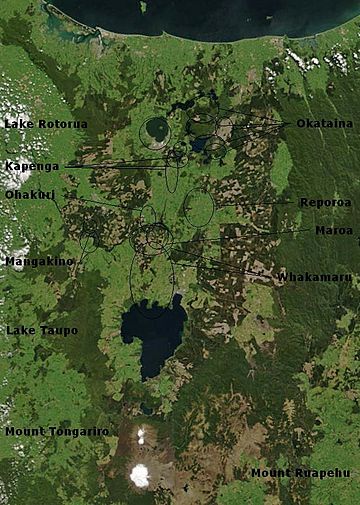
|
|
| Highest point | |
| Elevation | 452 m (1,483 ft) |
| Prominence | Motutaiko Island |
| Dimensions | |
| Width | 33 km (21 mi) |
| Geography | |
| Country | New Zealand |
| State/Province | Waikato |
| Geology | |
| Age of rock | Pleistocene - Meghalayan (0.3–0.0018Ma ) |
| Mountain type | Caldera |
| Volcanic arc/belt | Taupō Rift |
| Last eruption | About 250 CE |
| Climbing | |
| Access | State Highway 1 |
Lake Taupō, found in the middle of New Zealand's North Island, is actually the giant crater of the Taupō Volcano. This volcano is a huge supervolcano that has had two of the most powerful eruptions on Earth in recent history.
Timeline generation failed: 5 errors found
Line 78: at:-215,-1) textcolor:red fontsize:XS text:3
- PlotData attribute 'at' invalid.
Date '-215,-1)' does not conform to specified DateFormat yyyy.
Line 109: at:-253,4) textcolor:red fontsize:XS text:3
- PlotData attribute 'at' invalid.
Date '-253,4)' does not conform to specified DateFormat yyyy.
Line 117: at:-193,-5) textcolor:red fontsize:XS text:3
- PlotData attribute 'at' invalid.
Date '-193,-5)' does not conform to specified DateFormat yyyy.
Line 121: at:-253,4) textcolor:red fontsize:XS text:3
- PlotData attribute 'at' invalid.
Date '-253,4)' does not conform to specified DateFormat yyyy.
Line 126: at:253,4) textcolor:red fontsize:XS text:3
- PlotData attribute 'at' invalid.
Date '253,4)' does not conform to specified DateFormat yyyy.
Contents
Where is Taupō Volcano located?
The Taupō Volcano is part of the Taupō Volcanic Zone. This area has many active volcanoes. It stretches from Mount Ruapehu in the south, through the Taupō District and Rotorua Lakes areas, all the way to Whakaari/White Island in the Bay of Plenty.
Taupō Volcano started erupting about 300,000 years ago. Some of its biggest eruptions shaped the land we see today. These include the Mount Tauhara eruption 65,000 years ago and the Oruanui eruption about 26,500 years ago. The most recent major eruption was the Hatepe eruption, around 232 CE.
Is Taupō Volcano still active?
Taupō Volcano has not had a major eruption for about 1,800 years. However, scientists have been studying it since 1979. Their research shows that Taupō Volcano is still active. It has periods of "volcanic unrest," meaning it shows signs of activity.
Other volcanoes in the Taupō Volcanic Zone have erupted more recently. Mount Tarawera had a powerful eruption in 1886. Whakaari/White Island is often active, with its most recent eruption in December 2019.
What is rhyolitic magma?
The Taupō Volcano erupts a type of magma called rhyolite. This magma is thick and has a lot of silica in it.
If rhyolite magma doesn't have much gas, it usually forms a lava dome. But when it mixes with gas or steam, rhyolite eruptions can be super powerful! The magma turns into bubbly pumice and ash, which is shot out with incredible force.
How do volcanic plumes and flows form?
If the volcano creates a steady plume that goes high into the sky, the pumice and ash are carried sideways by the wind. They eventually fall to the ground, covering the landscape like snow.
Sometimes, the material thrown out cools quickly and becomes heavier than the air. It can't rise high, so it suddenly falls back down. This forms a pyroclastic flow. These flows hit the ground like a waterfall and spread out at amazing speeds. When the pumice and ash settle, they are hot enough to stick together and form a rock called ignimbrite. Pyroclastic flows can travel hundreds of kilometers an hour!
What were Taupō's earlier eruptions like?
Some very old ignimbrite eruptions happened further north of Taupō. Two of these, about 1.25 and 1.0 million years ago, were huge. They created a sheet of ignimbrite that covered much of the North Island.
While Taupō has been active for 300,000 years, big explosive eruptions became more common starting 65,000 years ago.
The Oruanui Eruption
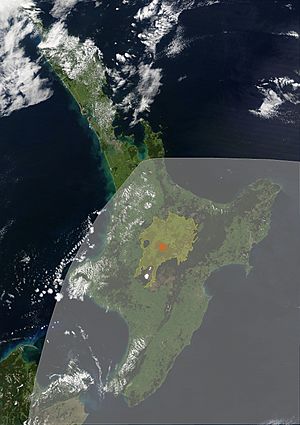
The Oruanui eruption of the Taupō Volcano was the largest known eruption in the world in the last 70,000 years. It happened around 26,500 years ago. This eruption was so big it scored an 8 on the Volcanic Explosivity Index.
It produced a massive amount of material. This included about 430 km3 (100 cu mi) of ash and pumice that fell from the sky. It also created about 320 km3 (77 cu mi) of pyroclastic density current deposits, mostly ignimbrite. All this came from about 530 km3 (130 cu mi) of magma.
Today's Lake Taupō partly fills the giant crater, or caldera, that formed during this eruption.
How did the Oruanui eruption change the land?
Ash from the Oruanui eruption covered most of the central North Island. In some places, the ignimbrite was up to 200 m (660 ft) deep. Even the Chatham Islands, 1,000 km (620 mi) away, got an 18 cm (7.1 in) layer of ash.
Over time, erosion and sedimentation changed the landscape. The Waikato River even moved its path. It used to flow to the Hauraki Plains but now goes through the Waikato to the Tasman Sea.
The Hatepe Eruption
The Hatepe eruption was the most recent major eruption of the Taupō Volcano. It happened about 1,800 years ago. This was the most powerful eruption in the world in the last 5,000 years.
What happened during the Hatepe eruption?
The eruption happened in several steps:
- A small eruption started under the old Lake Taupō.
- Then, activity greatly increased, sending a tall eruption column from a second opening. Pumice fell over a large area.
- Water mixed with magma in the first opening, creating a white, ash-rich pumice fall.
- A new opening formed, producing a dark ash and obsidian-rich fall.
- A much larger eruption followed, spreading pumice far and wide and creating a small ignimbrite deposit.
- The most destructive part came next. Part of the volcano's opening collapsed. This unleashed about 30 km3 (7.2 cu mi) of material. It formed a super-fast pyroclastic flow, moving at 600–900 km/h (370–560 mph).
- Years later, rhyolitic lava domes pushed out. These helped form the Horomatangi Reefs and Waitahanui bank. These smaller eruptions also made large floating pumice rafts and ended within decades of the main eruption.
The main pyroclastic flow destroyed the area around it. It climbed over 1,500 m (4,900 ft) to go over the nearby Kaimanawa Ranges and Mount Tongariro. It covered the land within 80 km (50 mi) with ignimbrite, from Rotorua to Waiouru. Only Mount Ruapehu was tall enough to block the flow.
The pyroclastic flow was so strong that in some places, it eroded more material from the ground than it left behind. Valleys were filled with ignimbrite, making the land flatter. All plants in the area were flattened. Loose pumice and ash created mudflows, called lahars, down all the main rivers.
The eruption also made the lake bigger. The old lake outlet was blocked, raising the lake 35 m (115 ft) higher than it is now. Eventually, the water broke through in a huge flood. This flood flowed for more than a week, at about 200 times the Waikato River's normal speed today.
When did the Hatepe eruption happen?
Scientists have used different ways to figure out the date of the Hatepe eruption. One early estimate from ice cores was 181 CE. Some thought it might be 186 CE, based on old writings from China and Rome. However, ash usually doesn't cross between the northern and southern halves of the Earth.
Later, radiocarbon dating suggested the date was 233 CE, plus or minus 13 years. A more recent study in 2011 using a method called wiggle-matching set the date at 232 CE, plus or minus 5 years. A 2021 review, looking at five different sources, reported 232 CE, plus or minus 10 years.
New Zealand was not populated by humans at that time. The closest people would have been in Australia and New Caledonia, over 2,000 km (1,200 mi) away.
What is Taupō's current activity and future risks?
From May to December 2022, there was more earthquake activity. The ground near the lake moved, causing small tsunamis. Because of this, the Volcanic Alert Level for Taupō Volcano was raised to Level 1 (minor volcanic unrest) on September 20, 2022.
No one has seen Taupō erupt, but there have been 17 times it showed signs of unrest since 1872. The most recent were in 2019 and 2022–2023. This unrest shows up as groups of small earthquakes and ground movement inside the caldera. Scientists believe there is a large amount of magma under the volcano, at least 250 km3 (60 cu mi) in size.
While Taupō can have very large eruptions, most of its 29 eruptions in the last 30,000 years have been much smaller. Many of these formed lava domes, which created features in the lake like Motutaiko Island and the Horomatangi Reefs.
There are also risks from earthquakes and tsunamis. Most earthquakes are small and happen when magma moves. But stronger earthquakes from eruptions or rift faults have caused tsunamis in the past. For example, the Waihi fault has caused 6.5 magnitude earthquakes every 490 to 1,380 years. At least one tsunami was caused by a landslide at the Hipaua steaming cliffs.
GNS Science constantly watches Taupō using seismographs (to detect earthquakes) and GPS stations (to track ground movement). The Horomatangi Reefs area of the lake has active hot springs and high heat. It's hard to monitor a volcano under a lake, and an eruption could happen with very little warning. You can see live data on the GeoNet website.
See also
 In Spanish: Volcán Taupo para niños
In Spanish: Volcán Taupo para niños
- Geology of New Zealand
- Geothermal areas in New Zealand
- Geothermal power in New Zealand
- List of volcanoes in New Zealand
- North Island Volcanic Plateau
- Rotorua Caldera
- Volcanism of New Zealand


